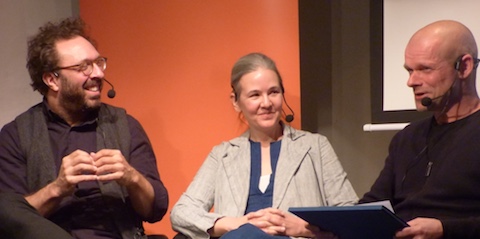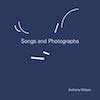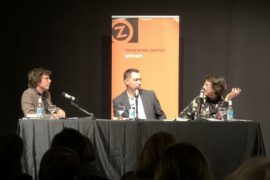Anthony Wilson created an audiovisual retreat from an increasingly chaotic world. He invites the listener to join him in his safe place. Unfortunately, it is easy to get lost on the way. At Literarisches Zentrum, Wilson offers insights into his composition process.
By Thorge Beilfuß
Pictures: Literarisches Zentrum Göttingen
Songs and Photographs by Grammy-nominated jazz composer and guitarist Anthony Wilson is exactly what it says on the cover. At least that much is true at first glance. Seeing this collection of songs and photographs, the latter meticulously arranged in high-quality print, one would assume that both elements connect in a certain way. If you had thought as much, I regret to say that it is a bit more complicated than that. But to get to the core of the issue we need to back up a little.
The Literarisches Zentrum is packed with people awaiting Wilson, who is presenting his newest work this evening. People longing for a purely musical evening will be disappointed: Wilson’s appearance is part of the event series Liederabend. That means before the audience can enjoy Wilsons pristine guitar play, the scheduled talk about the album has to commence. This is not necessarily a bad thing. The possibility to engage on a personal level with an artist’s work can further the appreciation of said artist and work. But the exchange has to flow freely. Gerhard Kaiser is leading through the evening. Wilson is accompanied by Nina Holland, who arranged and published the illustrations for her own publishing house Little Steidl. The three talk about the conception of the album, the creative process behind it, and genre in general. »Talk« might be the wrong word.

To the dubious benefit of the mostly bilingual audience, Kaiser questions Wilson in German. The ensuing translation debacle thwarts any and all natural colloquial flow. That is a shame, since Kaiser’s inquiries elicit charming anecdotes and fascinating insights into Wilson’s creative process. But instead of a free exchange unhindered by forced breaks, the conversation happens twice. The discussion grinds to a hold since moments to inquire further have to be passed over so that Kaiser can relate shortened translations of Wilson’s answers. Altogether, this results in a rather frustrating experience until Wilson picks up the guitar to break up the conversation’s monotonous rhythm.
»The Song Is the Destination«

Anthony Wilson
Songs and Photographs
Goat Hill Recordings and Little Steidl: L.A. and Göttingen 2018
48 pages, 10 songs, 87,00€
With Songs and Photographs Wilson wants to move away from the established conventions of jazz production. In that sense it is a departure from Frogtown, his preceding album, which was utilizing more experimental tunes. The new project has a rawness to it that makes it easy to fall into the music; a tribute to Wilson’s talent but also an effect of the recording process itself. Songs and Photographs was recorded within three days in a process resembling an improvisational music session. Wilson emphasizes the role of simplification over the course of the evening. He mentions minimal changes in guitar settings and amplifiers to keep the recording process from being overly complex. That sentiment is mirrored in the songwriting, which for a jazz album is surprisingly restrained. Unlike Frogtown, this album does not feature elaborate soli, exploring every inch of the musical spectrum, and the songs are surprisingly short. It is an intentional choice to go back to »the root of the song« and intentional departure from soli-focused songwriting. »The song is the destination. Five-minute soli, they often stand in the way of the core of the song.«
While Wilson breaks with some of the genre conventions, the link of photography and jazz draws on tradition. The great jazz albums of the past are fantastic examples of the power of photography. The Blue Note Records’ covers by Francis Wolff and Reid Miles come to mind. They, too, exude a rawness; a slice of spontaneity. Wilson is channeling a similar sentiment in his photography. The pictures he takes are not carefully arranged masterpieces of mise-en-scène but rather invitations to hold still for a second or two. Many of the photographs depict scenes we unconsciously erase from our daily perception. Wilson forces us to look and consider these scenes by pointing the lens at them. That can seem mundane; after all, we usually erase these scenes for a reason. The difference again lies in the process. Just as in the recording studio, Wilson goes old school, rejecting the digital in favor of the analog camera. Wilson’s photography suggests a fuller, more lived-in world than the one we can experience, if we move along our daily paths caught in the hectic lifestyle of the time.
What Does the Author Want Us to See?
At Literarisches Zentrum, it is hard to follow Wilson’s invitation. Some of the photographs are projected on a wall while he plays, but seem too random to connect to the music. Some suggest a connection to song titles – some defy that connection entirely. A picture of a flying pigeon is projected onto the wall for three songs. What does the author want us to see? In case of other photographs, Wilson offers anecdotes that relate to the lyrics and the connection becomes apparent.
Writing about Songs and Photographs presented a difficult task. Talking about artworks becomes easier with an angle pointing towards a point suggesting universality. Wilson’s work is always a bit out of reach for grasping its full impact. I talked to a lot of people that evening to ask for their perspective on the project that is Songs and Photographs. Everyone offered me a different connection they had to the album. Ultimately, the only universality I found was the subjective experience everyone had.
Earlier I said that it is unfortunately easy to get lost on the way to the place Wilson invites us to. Maybe that is not entirely correct. The subjective experience that is Songs and Photographs is its greatest strength. We can never really follow where Wilson went in creating this album and that is okay. It is the personal journey the music takes us on that is the destination. »We gotta start somewhere« – as long as we start at all.






